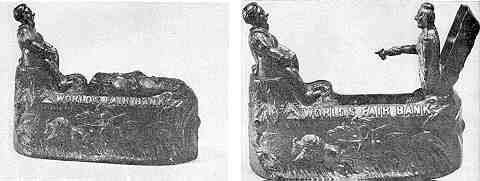World’s Fair Bank
by F.H. Griffith - HOBBIES Magazine - April, 1966

The World’s Fair Bank, our choice as No. 143 in the numerical classification, is a mechanical bank that we could say has a lot going for it. In the first place it represents an important event in our history, the discovery of America by Columbus. Along with this it commemorates an exhibition in honor of Columbus, the Worlds Columbian Exposition held in Chicago, Ill. Further the bank was designed by Charles A. Bailey, the greatest of all mechanical bank designers. Then it is a surprise type of bank in that there is nothing obvious about the action that takes place. These factors along with its ornate decorations, attractive appearance, and excellent action make the World’s Fair Bank add up to quite a desirable animated toy savings device. Another point of interest, it is one of only three known mechanical banks that utilize an Indian as part of the subject matter. The other two are Chief Big Moon (HOBBIES, March, 1965) and the Indian and Bear.
The World’s Fair Bank was patented October 10, 1893 by Charles A. Bailey of Cromwell, Conn., and assigned by him to the J. & E. Stevens Company of the same place. The bank as made by Stevens closely follows the four diagrams which are part of the patent papers. The bank pictured was made prior to the date of the issue of the patent and the terminology "Pat. Apld. For" appears on this bank under the word "World’s." It was first made in this fashion with the name thereon. Then for some years, after the World’s Columbian Exposition was over, it was made without the name. Thus, while the bank is generally known as the World’s Fair Bank, it is also often called Columbus And The Indian. Either name is appropriate since it was made with and without a name, and while the writer prefers the type with the name, actually one or the other is of about equal value. Stevens in their catalogs and advertising cards of the period simply called it the Columbus Bank.
The bank shown is in fine complete, original condition. It is painted simply but effectively as follows: The overall bank is gold including the figure of Columbus. A large flower by his left foot and the operating lever in the tree stump (upon which Columbus is seated) are in silver. The log in front of Columbus has a leafy vine and berry representation on it, and this is in silver. The figure of the Indian has bronze color legs, arms, face and neck. His clothing, headdress and peace pipe are silver. The inside of the log (which covers the Indian as in Figure 1) and the decorated section inside the bank, into which the Indian fits, are a tinted green silver color. The name World’s Fair Bank is highlighted in silver. The perforated base plate is quite decorative with the name "Columbus" in large letters curved across its length. The entire plate is painted brown. As can be seen in both Figures 1 and 2, the base has a fine embossed representation of a buffalo hunt with the Indian on horseback running down the buffalo. On the other side of the base there is considerable floral, leaf and vine work surrounding the center section. In relief in this section is a good representation of Columbus’ ship, the Santa Maria. So one can readily judge from the picture plus the description that this is a very ornately detailed toy savings device.
To operate the bank a coin is placed in the provided slot in front of the feet of Columbus (Figure 1). It stays in place resting against the end of the log. The lever is then pressed down. The log snaps up and back as the figure of the Indian rises to the position as shown in Figure 2. Columbus lifts his right arm in greeting as the Indian offers him the peace pipe. The coin meantime slides down a slot-like chute into the bank. On releasing the lever Columbus lowers his right arm. The log with the Indian must be pressed down by hand for further operation. The bank then appears as in Figure 1 ready for another coin. Coins are removed by means of the conventional round Stevens trap in the base plate.
The World’s Fair Bank is a sturdy well made mechanical bank. However, over the years, of the number of these banks seen by the writer, most of them have been broken. This is rather strange, and in most cases the breakage had to do with the figure of Columbus. The only logical explanation would seem to be that for some reason the World’s Fair Bank was subject to rougher treatment than most.
In closing, a point of kindred interest has to do with a cast iron bell ringing toy. In the period of the World’s Fair Bank, Bailey designed the Landing of Columbus bell toy. This was also made by Stevens and depicted Columbus in his ship along with some of the crew.
